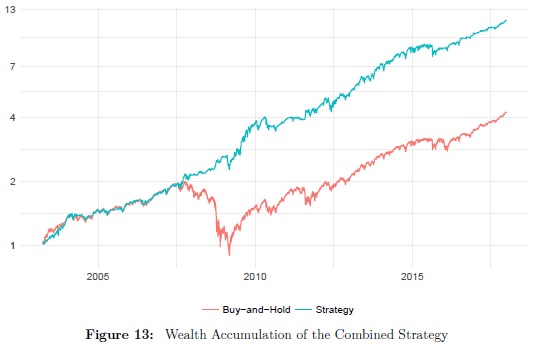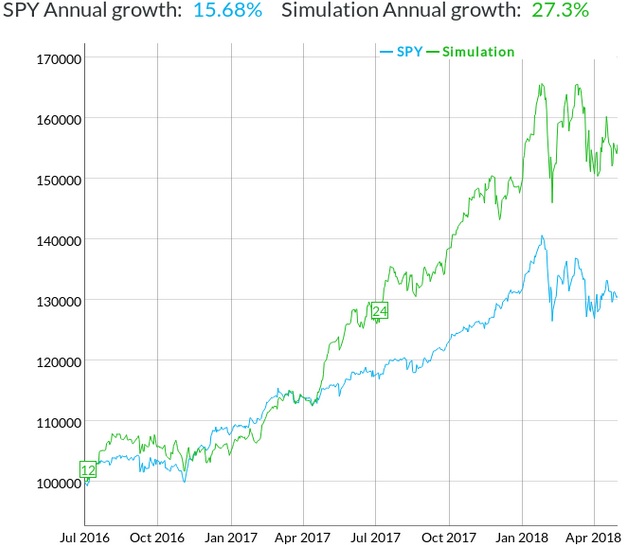A nice peak into the hedge funds industry kitchen. At the end, it is an additional evidence that a lot of hedge funds are trend-followers. And the main reason is that they are more successful because of it :
Authors: Liang, Zhang
Title: Do Hedge Funds Ride Market Irrationality?
Link: https://papers.ssrn.com/sol3/papers.cfm?abstract_id=3018483
Abstract:
We document significant evidence that hedge funds temporarily ride rather than attack high market irrationality but neither ride irrationality in the long run nor ride low irrationality. Hedge funds actively ride market irrationality during the formation period of the tech bubble in 2000 but not during the formation period of the housing bubble in 2007. Irrationality-riding funds outperform irrationality-attacking funds by 4.4% per year on a risk-adjusted basis. This outperformance is attributed to irrationality-riding during high irrationality periods-the formation period of the tech-bubble, and the bursting period of the housing bubble. The adoption of irrationality riding strategy is related to manager skill as well as investment styles. Our results are consistent with the behavioral theories that sophisticated investors ride rather than attack unsophisticated investors’ strong misperception. Finally, we do not find that mutual fund managers have the irrationality riding ability.
Notable quotations from the academic research paper:
"The conventional efficient market hypothesis (e.g., Freidman, 1953; Fama, 1965; Fama and French, 1996; Ross, 2001) suggests that rational investors attack market irrationality by conducting arbitrage trades to correct mispricing quickly and profit from their attacking strategy.
In contrast, behavioral studies (e.g., Delong, Shleifer, Summers and Waldman, 1990b; Abreu and Brunnermeier, 2002, 2003; Dumas, Kurshev and Uppal, 2009; Mendel and Shleifer, 2012) claim that rational investors choose to temporarily ride rather than attack noise traders’ high irrationality because the corresponding arbitrage may not be implementable. More interestingly, the behavior theory predicts that riding funds outperforms attacking funds, which is opposite to the conventional efficient market hypothesis theory.
This goal of this study is to distinguish the above two opposing views by empirically testing whether hedge funds, as rational investors, ride noise traders’ high irrationality in short run. Using a large sample of 5,617 equity-oriented hedge funds from the Lipper TASS database over the period from January 1994 to December 2013, we examine whether hedge fund managers ride or attack noise traders’ irrationality, by comparing the percentage of irrationality-riding funds with the portion of irrationality-attacking funds.
Following convention in the noise trading literature, we choose the noise trader sentiment index approximated by the Index of Consumer Sentiment from the University of Michigan as our base proxy for market-wide irrationality.2 We measure irrationality-riding via the timing coefficient in the conventional market timing models. Both the efficient market hypothesis and behavioral theory imply that hedge funds riding market irrationality should have significantly positive coefficients on the interaction term of the market index and the sentiment index, while funds that attack irrationality should have negative coefficients to offset the effect of irrationality on stock prices.
Out of the entire sample, about 20% of hedge fund managers have t-statistics of the riding coefficients equal to or greater than 1.65. The portion of hedge funds with a t-statistic equal to or lower than -1.65 is only 4.6%. These facts suggest that hedge fund managers do not attack, but ride noise traders’ irrationality.
This distribution pattern of the t-statistic significantly varies across investment styles. For example, 62.5% of multi-strategy funds and 35% of global macro funds adopt irrationality-riding strategy but the fraction of irrationality-riding funds among equity market neutral, convertible arbitrage or event driven funds is trivial. Moreover, the fraction of hedge funds with a t-statistic of riding coefficient equal to or greater than 1.65 is 31.4% during the high irrationality periods and is reduced to 17.0% during the lower irrationality periods. This fraction is 32.4% during normal time and 14.4% during the period of two financial crises, including the tech bubble crisis from March 2000 to December 2002 and the subprime crisis from June 2007 to December 2009. Hedge funds actively ride market irrationality during the tech bubble formation period from January 2000 to February 2000, but not during the housing bubble formation period from January 2005 to May 2007. Hedge fund managers do not show meaningful propensity to ride market irrationality in the long run either. The proportion of funds that choose to ride the 12-month leading market irrationality is smaller than the proportion that chooses to attack.
Further, we investigate whether hedge funds’ irrationality-riding choice is attributed to randomness or skill. In sum, our empirical results are consistent with the behavioral theory but not with the efficient market theory. We conclude that hedge fund managers choose to ride high market irrationality in the short run but to attack it in the long run.
Given the fact that market irrationality-riding is generally adopted by hedge funds, we examine whether this strategy is economically significant by comparing the performance of irrationality-riding funds with irrationality-attacking funds in subsequent periods.
The performance difference between the riding and attacking funds in the subsequent periods is consistent with the behavioral predictions but against the predictions of the efficient market hypothesis. The Fung and Hsieh (2004) seven-factor alpha delivered by the riding portfolio is at least 0.31 % per month, or equivalently 3.7% per year, significantly higher than that of the attacking portfolio over the subsequent one to twelve months. The risk-adjusted outperformance of the riding funds relative to the attacking funds in next one month is 0.49% (t-stat=12.02) during the high irrationality periods and -0.03% (t-stat=-0.90) during the low irrationality periods."
Are you looking for more strategies to read about? Check http://quantpedia.com/Screener
Do you want to see performance of trading systems we described? Check http://quantpedia.com/Chart/Performance
Do you want to know more about us? Check http://quantpedia.com/Home/About
Follow us on:
Facebook: https://www.facebook.com/quantpedia/
Twitter: https://twitter.com/quantpedia




















